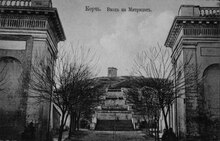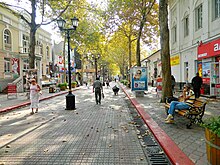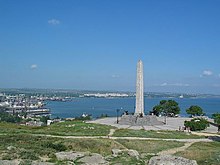Kerch
| Kerch | ||
| Керч | ||

|
|
|
| Basic data | ||
|---|---|---|
| Oblast : | Autonomous Republic of Crimea | |
| Rajon : | District-free city | |
| Height : | 10 m | |
| Area : | 108 km² | |
| Residents : | 149,566 (2017) | |
| Population density : | 1,385 inhabitants per km² | |
| Postcodes : | 98300 | |
| Area code : | +380 36561 | |
| Geographic location : | 45 ° 22 ' N , 36 ° 29' E | |
| KOATUU : | 111200000 | |
| Administrative structure : | 1 city | |
| Address: | вул. Кірова 17 98 300 м. Керч |
|
| Statistical information | ||
|
|
||
Kerch (Ukrainian Керч ; Russian Керчь ; Crimean Tatar Keriç ) is a port city on the Kerch peninsula of the same name with 144,500 inhabitants (2013).
geography
Kerch is located on the Kerch peninsula named after the city, which in turn forms the eastern end of the Crimean peninsula .
traffic
From here there is a constant ferry connection across the Kerch Strait to the Taman peninsula opposite to the port of Kawkas ( Russia ), from which there is a bus connection to Novorossiysk , about 150 km further south . The Crimean Bridge opened in 2018.
history
In the place of the city of Kerch was the ancient Pantikapaion , a Greek colonial city that was built in the seventh century BC. Was founded from Miletus and was later the seat of the kings of the Bosporan Empire . It was destroyed by the Huns in the fourth century AD . In the sixth century, the Byzantine fortress Bosphorus was built here. The Byzantine cavalry bowl found near the city in 1891 shows Emperor Constantius II as a triumphant on horseback.
After the Khazars -Herrschaft in the seventh century, when the town Karscha or Tscharscha called ( "the market"), she came in the tenth century as Kortschew under the control of the Kievan Rus , from 1239 under the Tatars -Herrschaft and then under the Golden Horde . For a time, the trading power of the Venetians and Genoese ruled over the city they called Vosporo , Bosporo or Cerkio . In 1340 Toloktomur, the then emir of Solgat (Crimea), offered the Venetians the city of Vosporo with its port and an associated area, so that they would be just as complete masters of it as the Genoese in Caffa .
It is not known when Kerch came to the Genoese. The earliest mention of a Genoese consulate in Kerch dates back to 1456. In the 15th century, Kerch belonged to the Crimean Khanate , and in 1475 the city, like all of Crimea, came under the influence of the Ottoman Empire . In 1774 Kerch and the Jeni-Kale fortress were annexed to the Russian Empire .
In 1821 Genoa-born Raffaele Scassi, businessman and friend of Grand Duke Michael Pavlovich Romanov , brother of Tsar I Alexander , received permission to build the port of Kerch , was appointed governor of the port, a loan of 200 thousand rubles and a ten-year loan Tax exemption on imported and exported goods to and from the Caucasus . The port was opened in December 1822.
In 1827 there was a Vice Consulate of the Kingdom of Sardinia in Kerch . By decree of October 4, 1828, Antonio Felice Garibaldi (1778-1846), the uncle of the Italian freedom fighter Giuseppe Garibaldi , was appointed Vice Consul of Kerch, and in 1832 Raffaele Chichizola was appointed Vice Consul in Kerch. After his death in 1851 he was replaced by his brother Pietro. The latter was also appointed commercial agent of the Kingdom of the Two Sicilies in Kerch in 1860. In 1884 Kerch became a vice consulate of the Kingdom of Italy .
In 1835 there was a " lovers' theater in Kerch , where the ladies and the local officials provide pleasant entertainment for the public through their successful game", and on October 18, 1835 "the city library and casino were opened with a feast." The first scheduled excavations in Kerch began in the 1830s . The place is named for the Kerch style , a characteristic ceramic style from Athens , which was especially exported to the Greek colonies on the Black Sea.
During the Crimean War , Kerch was destroyed by the British in 1855 as it played an important role in accessing the Sea of Azov , through which the Russians organized supplies to the Crimean Peninsula.
During the Second World War , Kerch was hotly contested. The city was conquered by the Wehrmacht for the first time after stiff resistance in November 1941 . On November 27, the local command office reported in its activity report to the commandant of the rear army area 553: "The liquidation of the Jews will be carried out more quickly because of the endangered food situation in the city." November to report on the hay market. From there they were transported by Sonderkommando 10b of Einsatzgruppe D of the security police and SD to the nearby village of Bagerowo , where they were shot in a tank ditch . Around 2500 Jews were murdered in this way from December 1st to 3rd.
On December 30th, when the Red Army landed at Sea, Kerch became a Soviet bridgehead . In May 1942, Kerch was captured again by the Wehrmacht, with an estimated 28,000 Soviet soldiers killed and 160,000 captured ( Operation Bustard Hunt ). Members of the Feldgendarmerie and Sonderkommando 10b tracked down surviving Jews who were then shot by the SD .
Around 10,000 non-evacuated Soviet soldiers, together with parts of the population, continued to offer bitter resistance in a mine (today's catacombs) until they were destroyed in October 1942 ( siege of the Adschimuschkai quarries ). On October 31, 1943, another Soviet sea landing failed. During the German occupation, 15,000 residents were killed and another 14,000 deported. These events were also used as evidence in the Nuremberg Trial . The largely destroyed city was liberated by the Red Army on April 11, 1944.
After the war, Kerch did not receive the status of a hero city and thus no central construction aid. Therefore, the city had to finance the reconstruction from its own resources. It was not until 1973 that Kerch was declared a city of heroes. The Kerch tram, which opened in 1935, was also destroyed in the course of the war in 1941 and not rebuilt. Since 1971, the city was connected to the North Crimean Canal , which supplied the Crimea with water from the Dnieper . This canal was separated by a dam after the annexation of Crimea by Russia , so that no water has been flowing from the Dnepr to the Crimea since 2014. In the meantime Kerch receives water a. a. from the Kerchensk reservoir west of the city.
At least 20 people were killed and 40 others injured in a rampage at a school on October 17, 2018. According to media reports, an 18-year-old student is said to have shot at least 19 people and then killed himself because of “hatred of the teachers”.
Italians in Kerch
In two waves of emigration (1820 and 1870) fishermen, merchants, captains, shipbuilders and farmers from Liguria , Campania and the Apulian cities of Trani , Bisceglie and Molfetta came to Kerch, soon followed by notaries, doctors, engineers, architects and artists.
In 1922 around 2,000 people of Italian descent lived in Kerch. They suffered from persecution in the 1930s and were deported to Kazakhstan and Siberia in three deportations (January 28-29, 1942, February 8-10, 1942, June 24, 1944) “for their own safety” . Of the approximately 2,000 deportees , around 300 returned to Kerch in the 1950s and 1960s.
population
Composition of the population according to the 2001 census:
| number | numbers in percent | |
|---|---|---|
| Russians | 124,430 | 78.7 |
| Ukrainians | 24,298 | 15.4 |
| Belarusians | 1,795 | 1.1 |
| Crimean Tatars | 1,635 | 1.0 |
| Armenians | 518 | 0.3 |
| Tatars | 383 | 0.2 |
| Jews | 322 | 0.2 |
| Moldovans | 280 | 0.2 |
| Azerbaijanis | 228 | 0.1 |
Population development
| 1897 | 1923 | 1926 | 1939 | 1959 | 1970 | 1979 | 1989 | 2001 | 2005 | 2013 |
|---|---|---|---|---|---|---|---|---|---|---|
| 33,347 | 25,986 | 34,624 | 104,443 | 98,769 | 127,608 | 156,827 | 174,365 | 157.007 | 152.564 | 144.504 |
Source: 1897–1989; 2001–2013
Attractions
- Mitridat Mountain with views of the city, the Kerch Strait , Tusla Island and the Russian Taman Peninsula
- Ruins of the Acropolis of Pantikapaion from the 6th century BC On Mount Mitridat
- Large Mithridates staircase with more than 400 steps, built 1833–1840 according to a project by the Italian architect Alexander Digby
- St. John Baptist , Byzantine church building
- Catholic church , built 1830–1840 in the classical style with Tuscan columns according to a design by the Italian architect Alexander Digby
- Tsar Kurgan from the 4th century BC Chr.
- Turkish fortress Jenikal from the 17th century
- WWII catacombs in a former mine
- The archaeological museum, founded in 1826, with the "Golden Larder".
- The memorial against cruelty and violence at the Kerch train station commemorates displaced ethnic groups.
structure
Until 1988, the city was divided into 3 Rajons (Kirov Raion, Lenin Raion, Ordzhonikidze Raion), which consisted of the incorporated places Arshynzewo (Аршинцево), Adschymushkaj (Аджимушкай), Herojewske (Герой Гневсекай), Yenikakky (Герой Гнвсекай), Hерой Гнвсекал , Kamyanka (Кам'янка) Kapkany (Капкани) Mytschuryno (Мичурино) Opasne (Опасне) Pidmajatschnyj (Підмаячній) Rybna (Рибна) Zhukovka (Жуковка) Soldatska Slobidka (Солдатська Слобідка) Synjahyno (Синягино) Wojkowa (Войкова), Zementnaja Slobidka (Цементна Слобідка). Since the dissolution of the Stadtrajons there is only one central city administration.
sons and daughters of the town
- Ippolit Prjanischnikow (1847–1921), Russian baritone, director and vocal teacher
- Nicolas Notovitch (1858 – after 1916), Russian journalist, editor and writer
- Iwan Lypa (1865–1923), Ukrainian writer, doctor and politician
- Lukas (Valentin Woino-Jassenezki; 1877–1961), Archbishop of Simferopol and Crimea and saint of the Russian Orthodox Church
- Mishel Piastro (1891–1970), American violinist and conductor
- Yevgenia Rudnewa (1920–1944), Soviet bomber pilot
- Alime Abdenanowa (1924–1944), Red Army soldier and spy in World War II
- Anatoli Grizenko (* 1958), Ukrainian-Russian politician
- Maria Efrosinina (* 1979), TV presenter
- Alexander Krasnoruzki (* 1987), Russian tennis player
- Valerija Strachowa (* 1995), tennis player
Town twinning
-
 Mahiljou , Belarus, since 1998
Mahiljou , Belarus, since 1998 -
 Smolensk , Russia, since 1998
Smolensk , Russia, since 1998 -
 Çanakkale , Turkey, since 1999
Çanakkale , Turkey, since 1999 -
 Oryol , Russia, since 2004
Oryol , Russia, since 2004 -
 Odintsovo , Russia, since 2004
Odintsovo , Russia, since 2004 -
 Sochi , Russia, since 2005
Sochi , Russia, since 2005 -
 Sevastopol , Ukraine, since 2009
Sevastopol , Ukraine, since 2009 -
 Temryuk , Russia, since 2012
Temryuk , Russia, since 2012 -
 Tula , Russia, since 2014
Tula , Russia, since 2014
Others
Discovered on June 12, 1972, the asteroid of the main outer belt (2216) Kerch was named after the city.
literature
- Silvano Gallon, Giulia Giacchetti Boico, Edoardo Canetta, Tito Manlio Altomare, Stefano Mensurati: Gli Italiani di Crimea. Nuovi documenti e testimonianze sulla deportazione e lo sterminio. (a cura di Giulio Vignoli), Edizioni Settimo Sigillo, Roma 2012, ISBN 978-88-6148-100-8 .
Web links
- City Administration (Russian)
- City Magazine (Russian)
- Kerch photos (russian)
Individual evidence
- ↑ a b Population development ( Memento of the original dated December 29, 2011 in the Internet Archive ) Info: The archive link was automatically inserted and not yet checked. Please check the original and archive link according to the instructions and then remove this notice. on World Gazetteer
- ^ Wilhelm Heyd: The Italian trading colonies on the Black Sea. (second article). In: Journal for the whole political science. , Volume 19, 1863, p. 163.
- ↑ a b Wilhelm Heyd: The Italian trading colonies on the Black Sea (second article). In: Journal for the whole political science. Volume 19, 1863, p. 184.
- ↑ Stefano Mensurati, Giulia Giacchetti Boico: Il genocidio Dimenticato. Gli italiani di Crimea. Libreria Editrice Goriziana, 2013, ISBN 978-88-6102-172-3 , p. 4.
- ↑ Rigasche Zeitung. No. 126, October 23, 1835, p. 2.
- ↑ Bert Hoppe (arr.): The persecution and murder of European Jews by National Socialist Germany 1933–1945. Volume 7: Soviet Union with annexed areas. Part I: Occupied Soviet territories under German military administration, the Baltic States and Transnistria . Oldenbourg, Munich 2011, ISBN 978-3-486-58911-5 , p. 389f; Quotation on p. 390, FN 6.
- ↑ Bert Hoppe (arr.): The persecution and murder of European Jews by National Socialist Germany 1933–1945. Volume 7: Soviet Union with annexed areas. Part I: Occupied Soviet territories under German military administration, the Baltic States and Transnistria . Oldenbourg, Munich 2011, ISBN 978-3-486-58911-5 , p. 390, FN 7.
- ↑ Many dead in a rampage in the Crimea , tagesschau.de, published and accessed on October 17, 2018.
- ↑ a b Act of violence on the Black Sea: 20 dead in a school rampage in the Crimea. In: Deutsche Welle . October 17, 2018, accessed October 17, 2018 .
- ↑ Stefano Mensurati, Giulia Giacchetti Boico: Il genocidio Dimenticato. Gli italiani di Crimea. Libreria Editrice Goriziana, 2013, ISBN 978-88-6102-172-3 , p. 9.
- ↑ sf.ukrstat.gov.ua ( Memento of the original from April 10, 2014 in the Internet Archive ) Info: The archive link was inserted automatically and has not yet been checked. Please check the original and archive link according to the instructions and then remove this notice.
- ↑ Demography of Ukrainian cities on pop-stat.mashke.org
- ↑ Antonia Kostretska: Terra incognita. Ukraine, Ukrainians and Ukrainian. An encyclopedic collection , GRIN Verlag , Munich 2017. Ethnic Germans , Tatars , Greeks , Bulgarians and Armenians were expelled . The Italians , who had been resident in Kerch since 1820, were not taken into account in the memorial .
- ^ Lutz D. Schmadel : Dictionary of Minor Planet Names . Fifth Revised and Enlarged Edition. Ed .: Lutz D. Schmadel. 5th edition. Springer Verlag , Berlin , Heidelberg 2003, ISBN 978-3-540-29925-7 , pp. 180 (English, 992 pp., Link.springer.com [ONLINE; accessed October 28, 2017] Original title: Dictionary of Minor Planet Names . First edition: Springer Verlag, Berlin, Heidelberg 1992): “Named for the hero city in the Crimea ”










